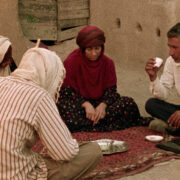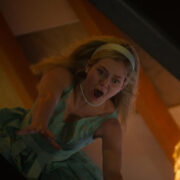Horrific Inquiry: THE MIST (2007)
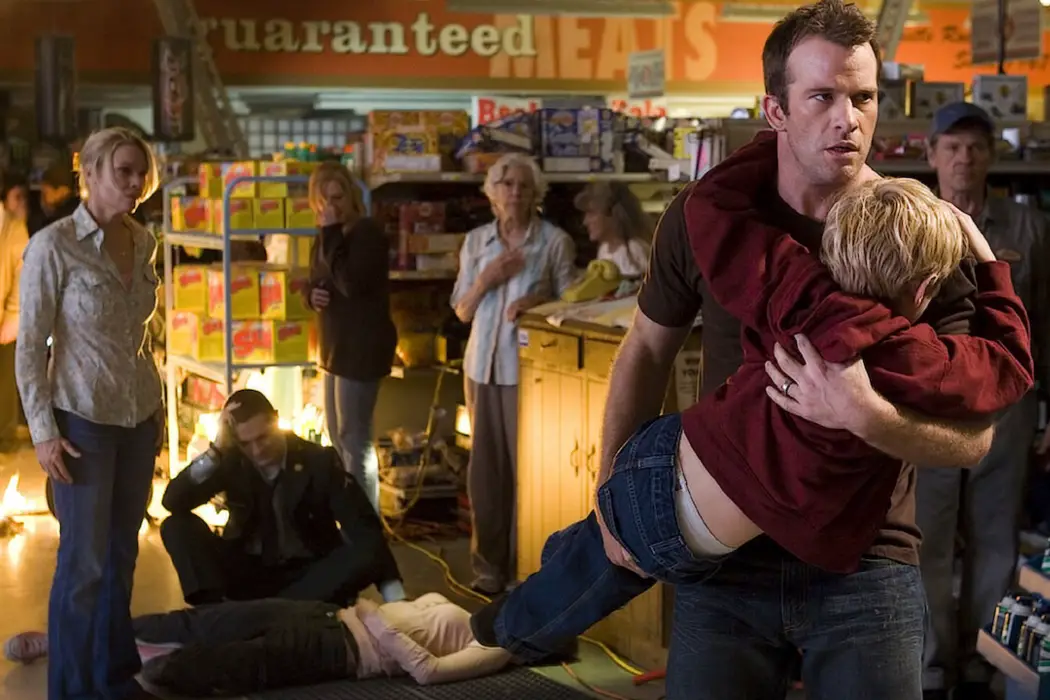
Stephanie Archer is 39 year old film fanatic living in…
Welcome back to the scariest, and at times goriest, column here at Film Inquiry: Horrific Inquiry. Twice a month, I will be tackling all things horror, bringing two films back into the spotlight to terrify and frighten once more. And occasionally looking at those that could have pushed the envelope further. Join us as we dive deep into the heart of horror, but warning, there will be spoilers.
As festival season came into full swing this fall, I had the opportunity to screen King on Screen at this year’s Fantastic Fest. And while the documentary covered a vast array of Stephen King adaptations, one, in particular, stuck with me, screaming for a rewatch – Frank Darabont’s The Mist. While I had seen the film before, it was the revelation through King on Screen that King himself had praised the revised ending that drew me to want to return. Its initial impact had been so, so, lingering on just memorable. The second time around, The Mist took on a whole new form.
Setting the Stage
There is a lot to unpack within The Mist, especially in the wake of the 202o pandemic and its societal effects that rippled through various psychoses. And while this new perspective exists, further heightening the effect of the film, it does not immediately take shape. As The Mist opens, it feels King. Immediately giving off Storm of the Century vibes, the camera pulls audiences in from the storm outside to the inside of an art studio, David Dayton (Thomas Jane) working on his film cover art, which includes King classics The Thing and The Dark Tower.
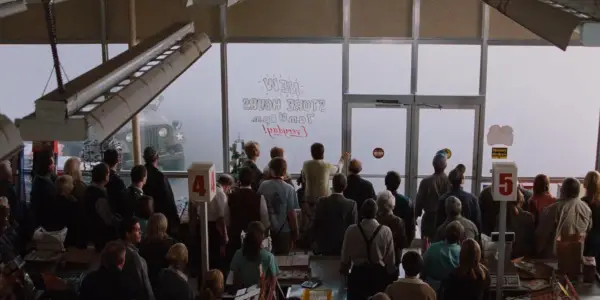
As the power goes out, the Dayton family looks out the window at the storm closing in, the lightening electrifying, its accompanying sound effects elevating its intensity. Whether you know where the story is going or not, viewers will immediately understand this is not a regular storm. Followed by the family running to the basement for shelter and a tree branch crashing through the window of the art studio, viewers are left to wonder what will be left when the storm passes.
As dawn breaks and the damage is assessed, there is little initial foreshadowing, The Mist leaning into the aftermath the storm has left in its wake. As David, his neighbor Brent (Andre Braugher), and his son Billy (Nathan Gamble) head into town for supplies, there is little concern that surrounds the small group or the family left behind. Yet with fog hovering over the water just offshore, the ominous feeling begins to settle back in, a military convoy racing in the direction of the fog heightening the sense of the danger to come, as well as providing credit to their reemergence by film’s end.
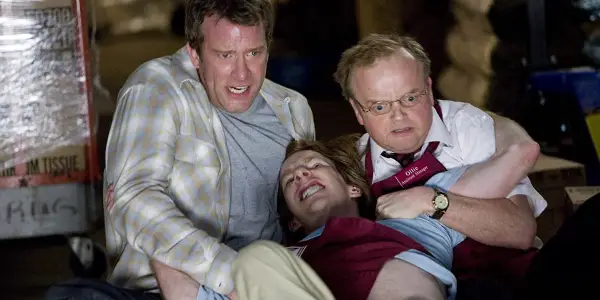
As David, Brent, and Billy arrive at the grocery store, The Mist is able to begin introducing its menagerie of characters as well as the limited set the film will be based within for the majority of its runtime. Yet, these are not just functional for set design and body count, these interactions introduce the comradery of the town’s inhabitants. It’s these interactions that set the tone of both the town and the psyche of those who are to become the film’s players. This baseline makes the cut through of tension, confusion, and fear that much more potent – sirens and the scream of Dan Miller (Jeffrey DeMunn), “there’s something in the mist”, tearing through the organized tranquility of the small town.
Coping
From here, The Mist feels as though it breaks down into multiple sections of narrative – giving insight not only into characters but the creatures outside in the mist they may eventually have to fight off. But it is not the sectionalization of narrative that viewers will find terrifying, but rather the sectionalization of characters.
While the initial reactions are more individually based, encapsulating themselves in the rationalizations of the mist descending on the market – “pollution cloud”, “it’s death”, “the goddamn mills exploded”, “it’s the end of days” and “it was an earthquake” – they slowly begin to merge into three clearly identifiable groups. And while the unknown creatures outside provide the gore, it is truly the townsfolk within the market that deliver the horror.
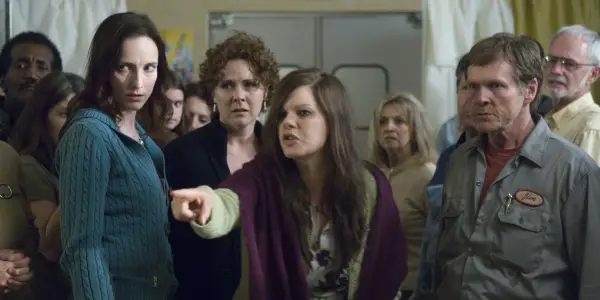
The power to rationalize is unique to the human species, delivering one of our most powerful forms of coping. Yet, so are denial and the will to survive. For The Mist, its three identifying groups encapsulate our means of coping. Denial delivers the swiftest recourse. In one of the most 2020 feels of the film, Brent leads the deniers and the naysayers. Initially believing that this is a trickery of revenge being played on him by David, it grows beyond one person, much demanding proof and delivering disbelief. Cries are rallied by David attempting to con people and question their intelligence. Even with death at the door and remanence of the creature in the stock room, denial prevails. So much so, Brent and his fellow group collectively decide to leave the market, a swift and painful death their only truth.
This denial is at its strongest as a group, slowly growing from the denial of Jim (William Sadler) and Norm (Chris Owen) in the stock room and spilling out into the rest of the market. And while denial is the first stage in this narratively constructed character study, the continuous fight to survive and the need for explanation round out the encapsulation of coping. The horror is not in the coping, but in what it provides through the interactions and escalating mentality of the survivors. For Mrs. Carmody, her initial introduction before the mist descends is elevated here, reinforcing not only her deeply ingrained beliefs, but the power she is able to wield on the other survivors because of those beliefs.
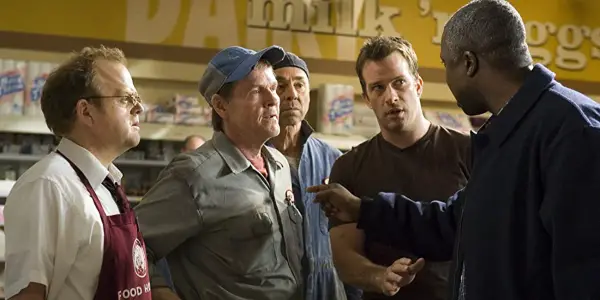
As each moment passes, both stagnant and escalating danger, her words of the destruction of man and the final judgment begin to come to fruition before the eyes of the survivors. She professes to the crowd that judgment is upon them, promising that the Lord’s judgment will return when the sun falls and more will die. As more creatures are introduced and more of the survivors in the market do die as Mrs. Carmondy predicted, there is a validity to her words and rationality of the present reality that many cling to. At this moment, when death feels imminent and the reckoning feels as though it truly is approaching, there is a comfort to her words and a need to believe – a need to be saved. Redemption can only be considered for those who fall to the Lord’s will.
As the hysteria swirling the growing mass of believers heightens, madness also sets in. As more begin to believe and listen to Mrs. Carmody, the unknown in the mist seemingly verifying the reckoning she preaches, the group begins to turn on the remaining survivors who have not conformed to the growing belief system. So much so, that when it is discovered the military may have been behind everything, the group turns on Private Jessup (Sam Witwer), killing him in a brutally horrific showcase of belief turned chaos. There is an imagery of Jesus presented as he is carried away, speaking to the horror that history repeats itself.
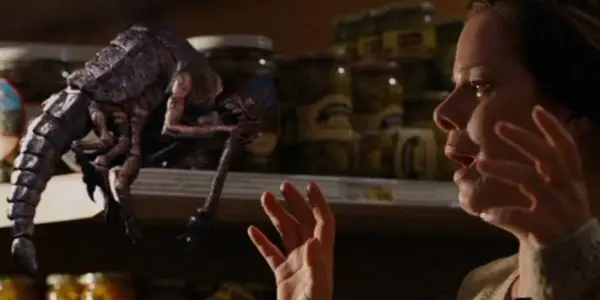
The final means to cope presented by The Mist is the fight to survive, the unrelenting strive to emerge from the mist on the other end of chaos. While many defects follow Mrs. Carmody, there is a solid core that is willing to do all it takes to survive – not just for themselves but for others. From the very beginning, this group strategizes and works to come up with the best course of action without giving into the denial or hysteria that would prevent them from accepting and reacting to their current reality. And while they have the foresight to know that staying in the market may not be the safest option as the crescendo of prayer, belief, and creature escalate, they too are not immune from the hysteria of chaos.
Hysteria
And here is where the true horror of The Mist arises. The film has thus far embraced societal reactions to the unknown, both individually and collectively. It has further embraced the horror that exists in the mist, quietly criticizing the curiosity of humanity and the consequences that might seemingly follow when unchecked. The Mist brings the gore, delivering a supernatural horror that breathes life into each element of its terror. Yet, it is here that Darabont builds off King‘s novella, delivering one of the most horrifically devastating moments in cinema.
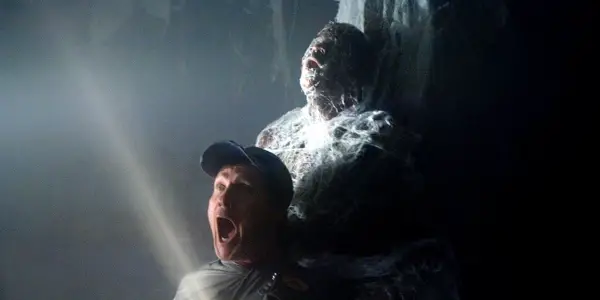
As the band of survivors leaves the market, determined to escape the town and the mist, viewers are left watching them quietly maneuver through the destruction within the mist by the various creatures. Their view is severely obscured, yet they make their way slowly and surely, hoping to find the end of the mist’s reach. As the car runs out of gas and it rolls to a stop, the five remaining survivors – David, Amanda (Laurie Holden), Dan, Irene (Frances Sternhagen), and Billy – face the reality that their time has come. In this moment, the calculations behind their reactions melt away, David slowly pulling the gun from his pocket. As he checks the ammunition, he finds there are only four bullets remaining.
Weighing a mercy killing versus a brutal death by the creatures outside, David shoots each member in the car, his son’s face awakening just before he is shot the last image both David and viewers are given of the life that had fought so hard to survive. The emotional ramifications of David’s actions are immediate as he stumbles out of the car screaming into the void, calling for his own death at the hand of the creatures. But mercy never comes, the military arriving and the mist dissipating, revealing the horror both inside and outside of the car. As David screams in terror, we as viewers come to understand that the mist was not only a mystical horror housing terrifying and brutal creatures, but it was the mist of the mind, clouding judgment, reasoning, and patience – and that no one is immune.
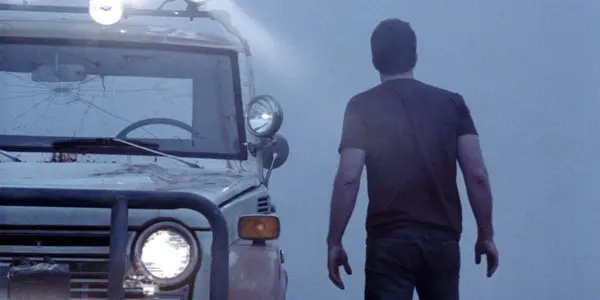
The Mist crescendos to this devastating moment, the final culmination of hysteria and the human psyche in distress. Had the members in the car given themselves a moment before jumping off the deep end, they might all be alive. As much as they judge the hysteria of others, the final five fall to their own hysteria when faced with the finality of the fight and the perceived certainty of death. Had they just taken a moment, things would have been different. In this moment, the horror is no longer the monsters outside the car, but the knee-jerk hysteria and reactionary behavior of the human species. And it is a potent message that screams into the annals of the mind as the credits begin to roll.
Conclusion
While The Mist takes on a whole new perspective following the 2020 pandemic, it still retains the weight and importance of its horror laced within human reaction and psyche. And for all the King adaptions that have graced our screens, The Mist is one of the most horrific and the most lived in. Beyond the creatures and the supernatural, there is a realism to the film that speaks volumes. As The Mist concluded, I found myself wanting to watch it again. Nuanced and deeply layered, The Mist proves itself not only to be a well-crafted horror but an example of the true power of adaptations.
Watch The Mist
Does content like this matter to you?
Become a Member and support film journalism. Unlock access to all of Film Inquiry`s great articles. Join a community of like-minded readers who are passionate about cinema - get access to our private members Network, give back to independent filmmakers, and more.










